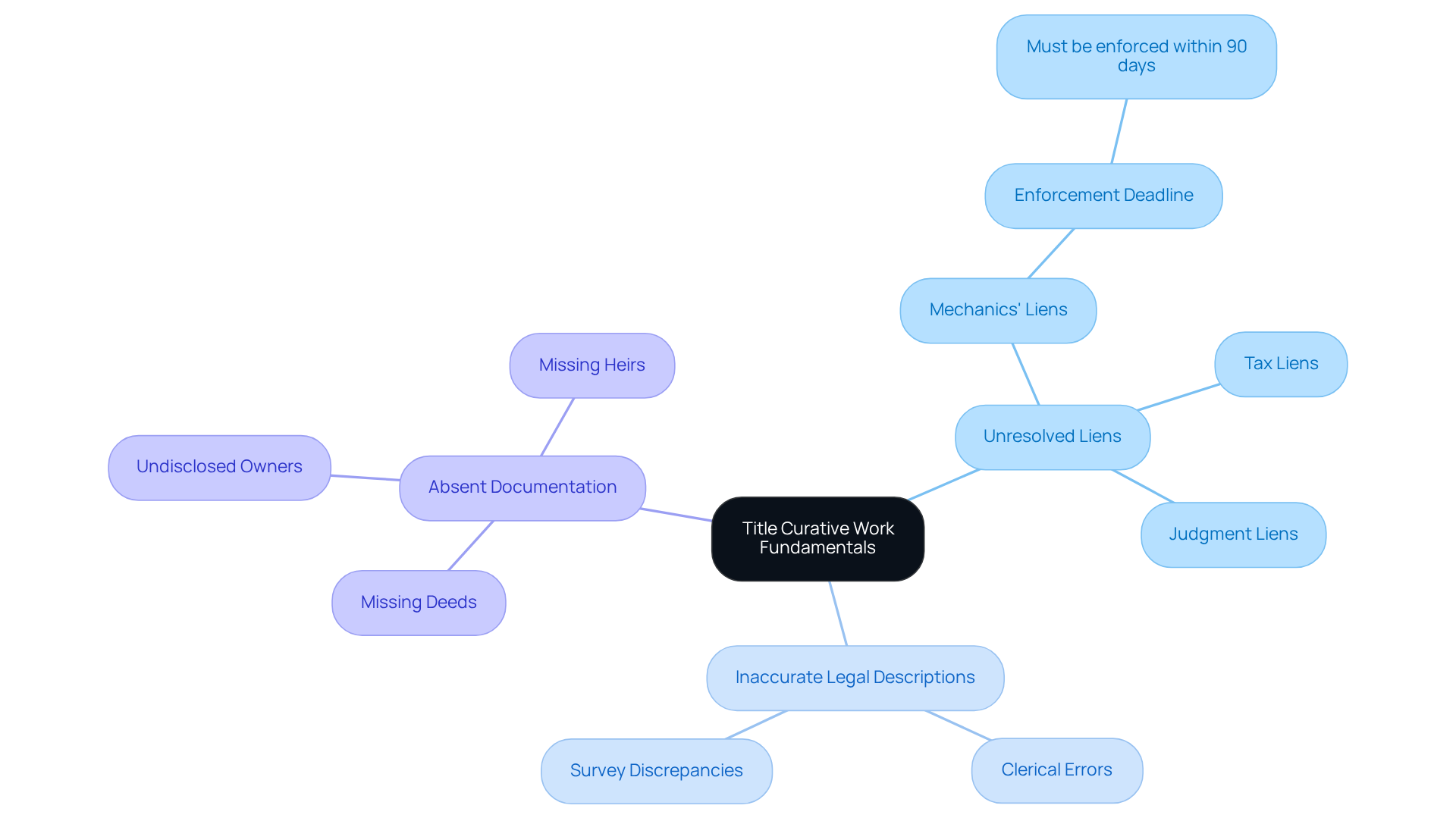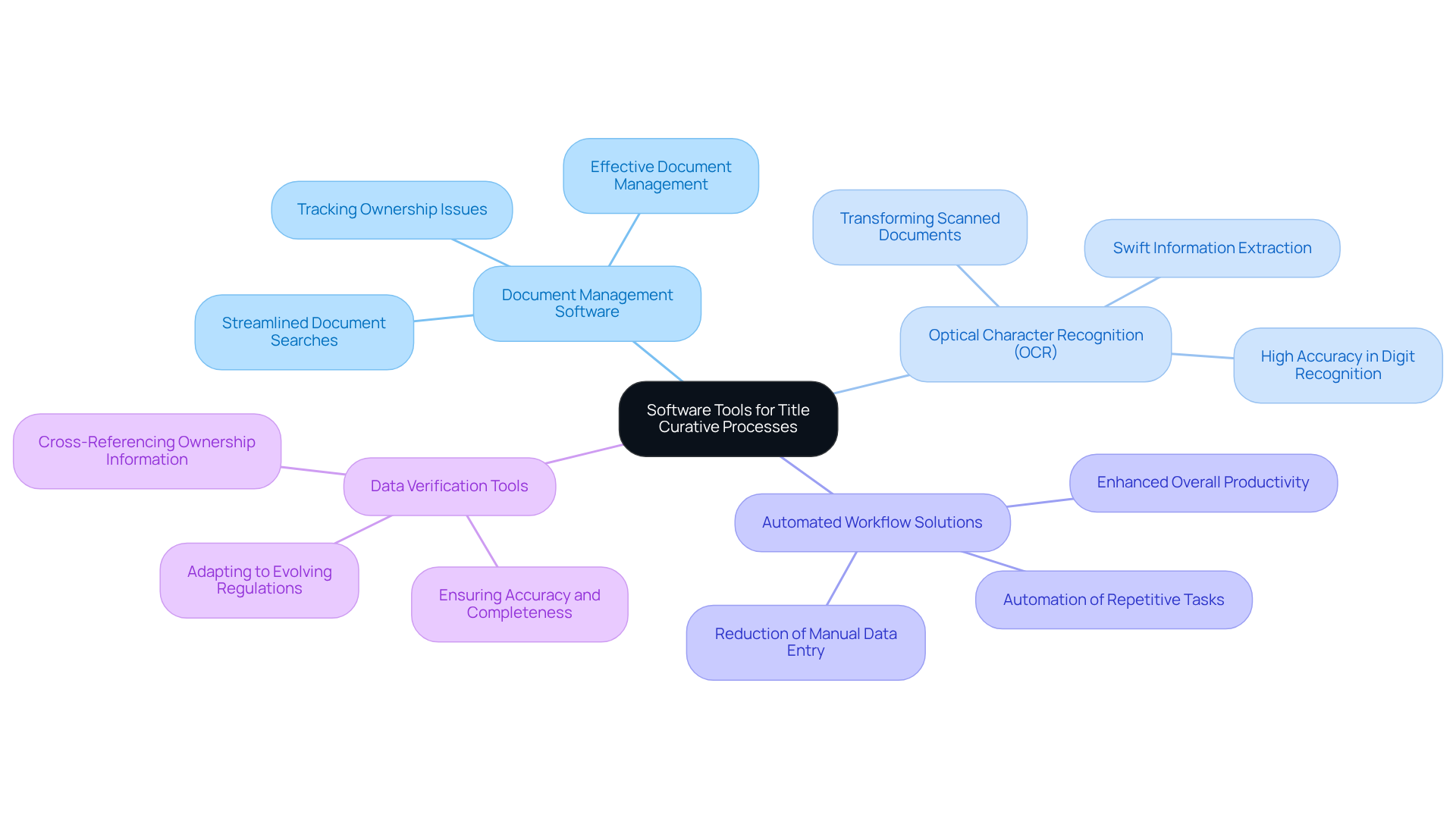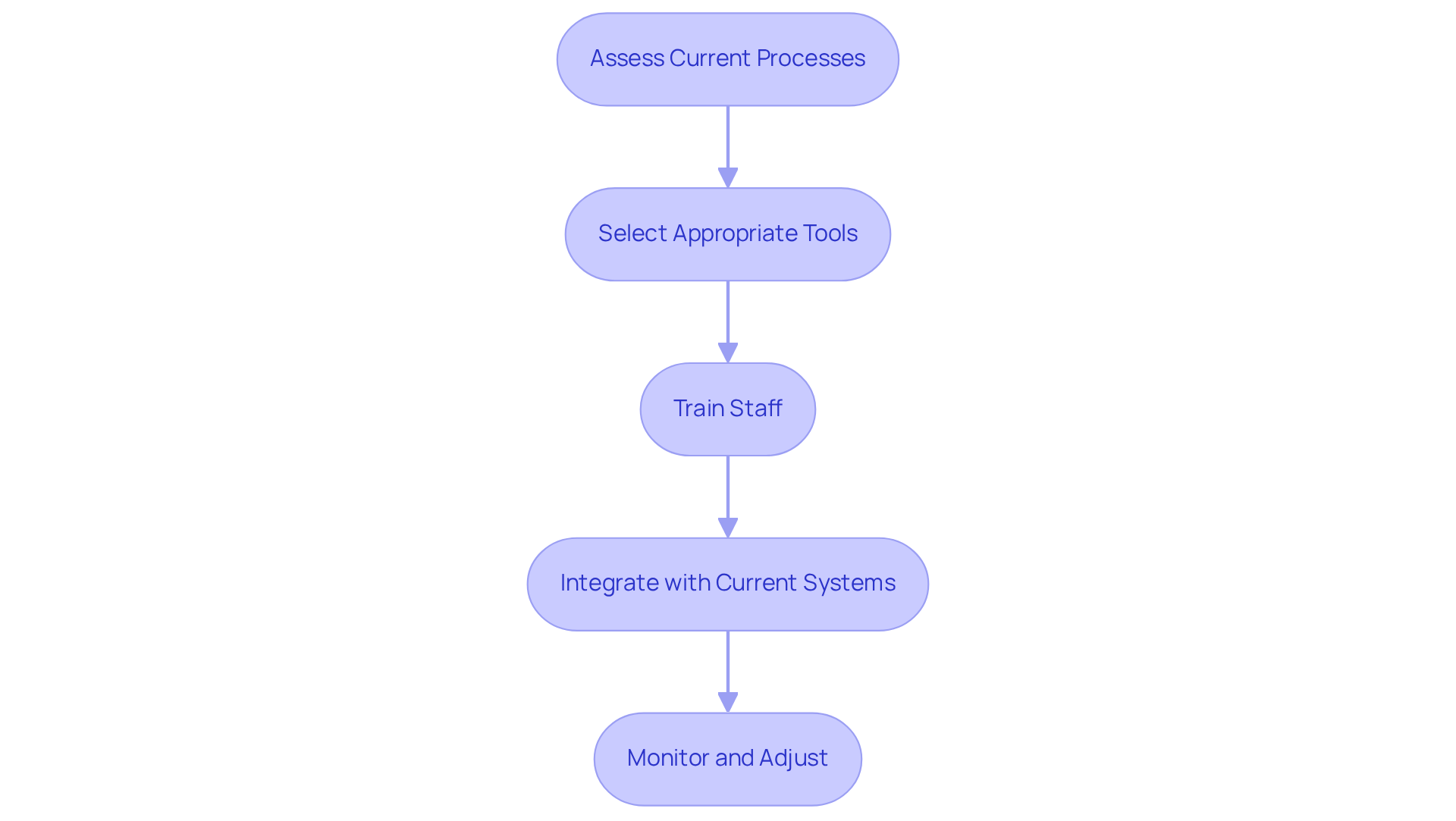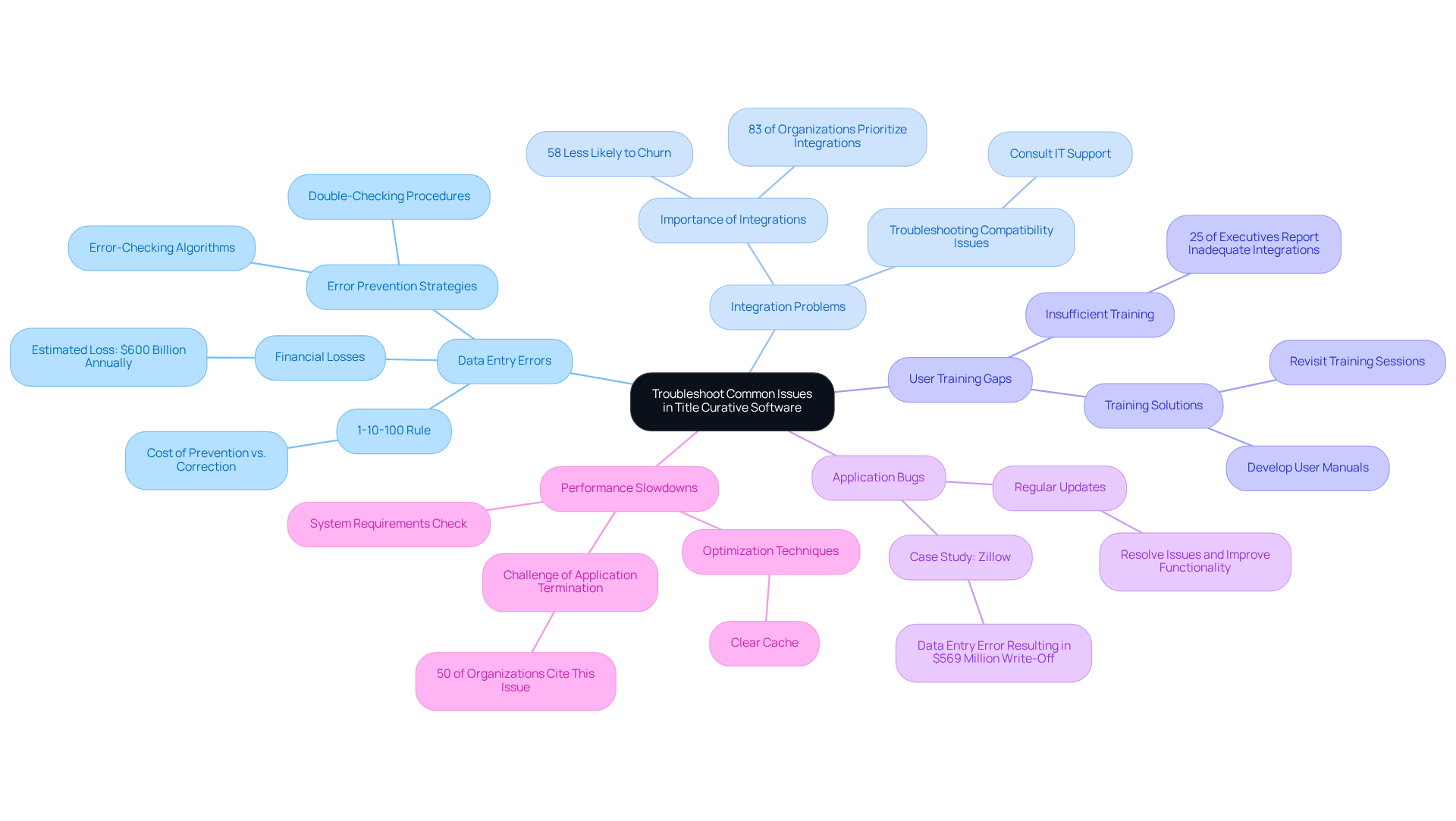Overview
Software significantly enhances title curative work by streamlining document management, automating workflows, and ensuring data accuracy. These advancements collectively improve efficiency in resolving ownership issues. Furthermore, various software tools, such as document management systems and OCR technology, facilitate quicker identification and rectification of title defects. Consequently, this leads to smoother real estate transactions, underscoring the importance of accurate title research in overcoming challenges faced in the industry.
Introduction
In the intricate world of real estate, title curative work is a critical safeguard against ownership disputes and transaction delays. As property transactions increasingly rely on accurate documentation and the swift resolution of title defects, the integration of advanced software tools has emerged as a game-changer for real estate professionals. Furthermore, with approximately 25% of residential transactions facing ownership challenges, the pressing question remains: how can these software solutions effectively streamline the title curative process and mitigate potential pitfalls?
Understand Title Curative Work Fundamentals
Curative work for is essential for identifying and resolving documents, highlighting how software helps with to prevent obstruction in . Frequent problems include:
- Unresolved liens
- Inaccurate legal descriptions
- Absent documentation
For instance, in California, mechanics' liens must be enforced within 90 days of recording, or they become unenforceable, underscoring the urgency of addressing such defects. Statistically, around 25% of residential real estate transactions face , which experts address before closing, according to the American Land Title Association (ALTA). Understanding these fundamentals is crucial for real estate professionals, as can significantly delay or obstruct transactions. Familiarity with terms such as '' and '[defects in ownership](https://estavillolaw.com/common-title-defects-and-how-to-resolve-them-for-a-smooth-closing)' enables experts to navigate the complexities of property ownership verification effectively. Furthermore, it is important to recognize that liens are claims against property for unpaid debts, which can exist without the owner's knowledge. By proactively addressing these challenges and ensuring accurate public records, real estate professionals can enhance their workflow efficiency and illustrate how software helps with [title curative work](https://blog.onevalor.com/understanding-title-curative) to facilitate smoother transactions.

Explore Software Tools for Title Curative Processes
A range of software tools is essential in enhancing , illustrating how by providing distinct functionalities that promote increased efficiency and precision.
- : Solutions such as Qualia and SoftPro streamline document searches and curative processes. These platforms show how software helps with title curative work by enabling effective document management and tracking, . The insurance market for property, valued at $22.6 billion in 2023 and projected to rise to $23.0 billion in 2024, increasingly embraces such technologies to meet the growing demands for efficiency in .
- : into editable text, allowing specialists to swiftly extract relevant information from documentation. With OCR anticipated to expand at a CAGR of 16%, its effectiveness in research is underscored by the RUCI Lab's achievement of over 99% accuracy in digit recognition, demonstrating its reliability in managing complex documents.
- : These platforms automate repetitive tasks, significantly reducing the time spent on manual data entry. By enabling professionals to concentrate on more complex issues, automated workflows enhance overall productivity. In the insurance sector, the integration of AI and machine learning is showcasing how software helps with title curative work by revolutionizing operational efficiency.
- Data Verification Tools: Software that cross-references with external databases ensures accuracy and completeness in research. This verification process is vital in a market characterized by evolving regulations and compliance standards, where accurate ownership information is paramount. Moreover, the challenges posed by competition and regulatory changes further highlight the importance of these tools.
By utilizing these , professionals can significantly enhance their efficiency and precision in addressing defects, particularly through understanding how software helps with title curative work, ultimately leading to improved service delivery in the real estate sector.

Implement Software Solutions in Title Research Workflows
To implement software solutions in title research workflows, follow these steps:
- Assess Current Processes: Evaluate existing workflows to identify bottlenecks and areas for improvement. This assessment is crucial for determining will be most advantageous. Industry insights reveal that 70% of organizations migrating to , underscoring the importance of this evaluation.
- Select Appropriate Tools: Choose applications that align with your specific needs. Consider factors such as ease of use, integration capabilities, and customer support. As highlighted by industry leaders, selecting the right tools is essential for achieving strategic business objectives.
- Train Staff: Provide comprehensive training for all team members on effectively using the new application. This ensures that everyone is aligned and can utilize the tools to their full potential. ; in fact, 63% of employees cease using tools if they do not perceive their relevance to daily tasks.
- Integrate with Current Systems: Ensure that the new application integrates smoothly with existing systems to avoid workflow disruptions. Collaborating with IT professionals may be necessary to establish the required connections. The seamless incorporation of applications is vital for maximizing benefits, as demonstrated by firms that have successfully adopted new technologies.
- Monitor and Adjust: After implementation, continuously . Make adjustments as needed to optimize its use in your workflows. Ongoing enhancement is essential, as emphasized by to address persistent challenges in property research.
By following these steps, real estate firms can significantly enhance their research efficiency, demonstrating how , ultimately leading to improved outcomes and cost savings. As industry leaders emphasize, transcends the mere adoption of new tools; it involves .

Troubleshoot Common Issues in Title Curative Software
Common issues that may arise when using title curative software include:
- : Accurate data entry is crucial in title research, as errors can lead to significant financial losses and legal complications. Businesses in the U.S. lose an estimated $600 billion annually due to data entry errors. Implementing double-checking procedures and utilizing error-checking algorithms can help catch mistakes before they impact workflows. The illustrates that preventing errors at the data entry stage is the most cost-effective strategy, as correcting them later can escalate costs exponentially.
- Integration Problems: can hinder the effectiveness of title management systems. Statistics show that 83% of organizations prioritize product integrations, highlighting their importance in improving operational efficiency. Furthermore, integration users are 58% less likely to churn, emphasizing the role of integrations in client retention. If the application does not integrate well with existing systems, consult with IT support to troubleshoot and resolve compatibility issues, ensuring seamless data flow.
- : Insufficient training can lead to user errors and inefficiencies. Revisiting training sessions to address knowledge gaps is essential. Additionally, 25% of executives report that their CRM systems lack adequate integrations, underscoring the need for effective training in using integrated systems. Consider developing user manuals or quick reference guides to help users navigate the application effectively.
- : Regular updates are essential for resolving issues and improving functionality. A notable case is Zillow's data entry error, which led to the purchase of 27,000 homes at unsustainable prices, resulting in a $569 million write-off. If challenges continue, reaching out to the application provider for assistance can aid in addressing persistent troubles, ensuring that the system functions seamlessly.
- : Slow software performance can disrupt workflows. Check system requirements to ensure hardware compatibility, and consider clearing cache and optimizing system performance to enhance speed. Furthermore, 50% of organizations mention the termination of an integrated application as a challenge, which can lead to performance problems.
By proactively addressing these issues, title professionals can maintain a smooth and efficient title curative process, which illustrates how software helps with title curative work and ultimately safeguards the integrity of property transactions.

Conclusion
Embracing software solutions in title curative work is pivotal for enhancing the efficiency and accuracy of real estate transactions. By leveraging advanced technologies, professionals can effectively address ownership defects, streamline processes, and ultimately ensure smoother closings. The integration of software not only mitigates common challenges but also empowers teams to focus on resolving complex issues, thereby reinforcing the importance of title curative work in maintaining the integrity of property transactions.
The article highlights several key aspects of how software aids in title curative processes. From document management tools that simplify searches to automated workflows that enhance productivity, each software solution plays a critical role in overcoming obstacles such as data entry errors and integration problems. By understanding and implementing these technologies, real estate professionals can significantly reduce the time and effort required to rectify ownership issues, leading to improved service delivery and client satisfaction.
In conclusion, the adoption of software tools in title curative work is not merely a trend but a necessary evolution in the real estate sector. As the industry continues to face increasing demands for efficiency and accuracy, embracing these solutions is essential. Real estate professionals are encouraged to assess their current workflows, select appropriate software tools, and commit to ongoing training and integration efforts. By doing so, they can not only enhance their operational capabilities but also contribute to a more reliable and efficient real estate market.
Frequently Asked Questions
What is title curative work?
Title curative work involves identifying and resolving defects in ownership documents to ensure clear property ownership and prevent obstructions in real estate transactions.
What are common problems encountered in title curative work?
Common problems include unresolved liens, inaccurate legal descriptions, and absent documentation.
Why is it important to address mechanics' liens promptly?
In California, mechanics' liens must be enforced within 90 days of recording; otherwise, they become unenforceable, highlighting the urgency of addressing such defects.
How prevalent are ownership challenges in residential real estate transactions?
Approximately 25% of residential real estate transactions face ownership challenges, which experts typically resolve before closing, according to the American Land Title Association (ALTA).
Why is understanding title curative work fundamentals important for real estate professionals?
Understanding these fundamentals is crucial because ownership issues can significantly delay or obstruct real estate transactions.
What terms should real estate professionals be familiar with regarding ownership verification?
Real estate professionals should be familiar with terms such as 'cloud on ownership' and 'defects in ownership' to navigate the complexities of property ownership verification effectively.
What are liens in the context of property ownership?
Liens are claims against property for unpaid debts, which can exist without the owner's knowledge.
How can software assist in title curative work?
Software can enhance workflow efficiency by helping real estate professionals address title defects and ensure accurate public records, facilitating smoother transactions.




